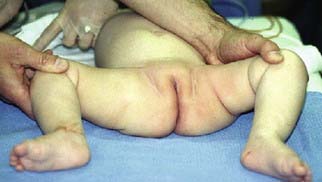Chapter 17 Teaching Visual
Examination of the Infant Hip
Medical Knowledge
Because the hip contains a high percentage of cartilage at birth, regular examinations are performed during the first year of life to detect abnormalities as the hip grows and undergoes ossification. The goals are to detect developing dysplasia, to prevent or successfully treat hip dislocation, and to avoid development of avascular necrosis (AVN) of the femoral head. DDH may include underdevelopment or dysplasia of the acetabulum, or the femoral head may be abnormally positioned within the acetabulum, which may lead to frank dislocation (luxation), partial dislocation (subluxation), or instability, whereby the femoral head slides in and out of the acetabulum.1 Risk factors for DDH include female gender, firstborn child, breech presentation, or a family history of DDH.2
The Ortolani and Barlow maneuvers are performed on infants from birth through 12 weeks of age. The Barlow maneuver is a gentle attempt to sublux or dislocate the femoral head from an unstable hip. The Ortolani maneuver is an attempt to relocate a dislocated hip. If either the Ortolani or Barlow is elicited, it is a positive examination for DDH. After 12 weeks of age, these maneuvers become increasingly less reliable.1,2 Limitation of abduction is the most reliable sign of DDH after 3 months of age. Normal abduction is symmetric and nearly complete; that is, the knees should come close to touching the examination table3. Asymmetry of thigh and gluteal folds or suspected leg length discrepancy raises suspicion for DDH, but is not diagnostic.1 In the neonate, soft tissue “clicks” are common and are usually due to ligamentous laxity caused by maternal hormones and do not indicate DDH. It is important to distinguish a soft tissue “click” from the rarely felt “clunk” of frank femoral head dislocation.
The infant is ideally examined in a quiet state lying supine. With the diaper open, first observe for symmetry of the anterior thigh creases (Figure 17-1).

Figure 17-1 Note asymmetric anterior thigh creases in an infant with developmental dysplasia of the hip.
Stay updated, free articles. Join our Telegram channel

Full access? Get Clinical Tree






